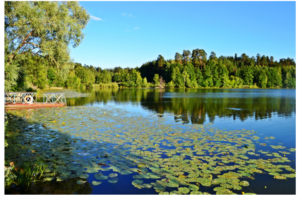ГДЗ по английскому языку 10 класс упражнение - 1 р 7
It’s one of the most famous lakes in the world and it’s one of Russia’s greatest landmarks.
Spotlight on Russia turns its attention to …
Lake Baikal
Lake Baikal, in eastern Siberia, is a miracle of nature. It’s the deepest lake on Earth and it contains more water than all the Great Lakes of America put together. It’s also the oldest lake on Earth and, after more than 25 million years, Lake Baikal is still growing at a rate of 2 cm a year. However, facts and figures fail to describe the breathtaking beauty of Baikal. The water is crystal clear, and when you can see the shimmering stones on the bottom of the lake it’s hard to believe they’re so deep down. But then this tranquillity can easily become a tempest. As the lake changes its mood, the wind rises and huge waves begin to roll across the surface.
Lake Baikal is surrounded by some magnificent mountain ranges, such as the Primorsky, Baikalsky and Barguzinsky. More than 300 rivers flow into Lake Baikal and only one river, the Angara, flows outwards. Of the 27 islands in the lake, the most famous is Olkhon Island, where they say the sun shines brightly for more than 300 days a year. Olkhon is a place of legend and wild spirits, and it’s home to the famous Shamanka Rock, sacred to shamans in times gone by.
This environmental treasure also contains a wealth of biodiversity. Most of the 2,635 species of animals and plants discovered in and around Lake Baikal cannot be found anywhere else in the world. The lake is also the only breeding ground for the Baikal Seal and the Omul fish, on which the seals feed. In 1996, Baikal was declared a UNESCO World Heritage Site. The total area of the site is 8.8 million hectares, which includes the lake’s surface, three reserves, and two national parks, Pribaikalsky and Tunkinsky.
Today, this precious Russian jewel is threatened by the industry around its shores. We can only hope that future generations will be able to come here and enjoy Lake Baikal as much as we do.
Is there an area near you that is particularly beautiful? What makes it so special? What do people do there? Send Spotlight on Russia some drawings or photographs of your special place.
- In pairs, discuss what you find most impressive about Lake Baikal.
- What would you like to do there?
- How can people help to protect this fragile environment? Collect information using the Internet.
Is there an area near you that is particularly beautiful? What makes it so special?

Near Kazan, one particularly beautiful area is the Volga-Kama Nature Reserve, located where the Volga and Kama rivers meet. This reserve is special because it preserves unique natural landscapes, forests, and wetlands that are home to many rare plants and animals. The peaceful rivers, green forests, and diverse wildlife make it a perfect place for nature lovers.
What do people do there?
People visit the reserve to enjoy hiking, birdwatching, and boat trips along the rivers. It’s a great place to relax, take photographs, and experience the natural beauty of the region. The reserve also helps protect the environment by preserving habitats and educating visitors about nature conservation.
What do you find most impressive about Lake Baikal?
Lake Baikal is the deepest and oldest freshwater lake in the world, containing about 20% of the world’s unfrozen fresh water. Its water is incredibly clear and pure, and it is home to thousands of unique species, including the Baikal seal – the only freshwater seal in the world. The lake’s vast size, natural beauty, and biodiversity make it a true natural wonder.
What would you like to do there?
I would love to hike parts of the Great Baikal Trail, explore the beautiful villages like Listvyanka, and take a boat trip to see the famous Shaman Rock and Olkhon Island. In winter, I’d be interested in trying ice skating or even a dogsled tour across the frozen lake.
How can people help to protect this fragile environment?
- avoid littering and always take trash with you
- use eco-friendly products to prevent water pollution
- support local conservation projects and national parks
- respect wildlife and natural habitats by keeping a safe distance
- promote awareness about the importance of preserving this fragile environment